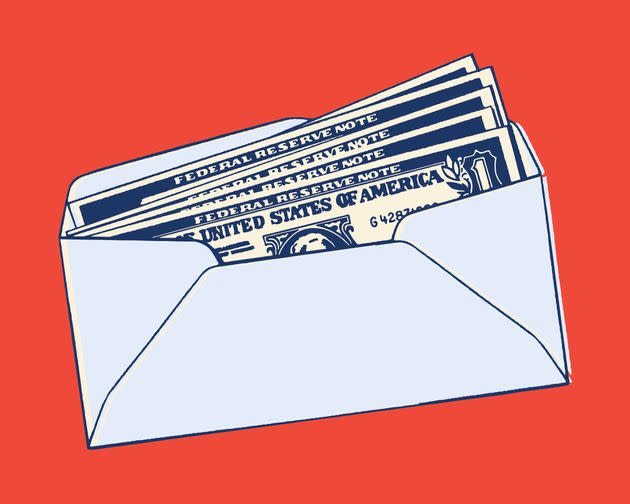Is The '100 Envelope Challenge' Actually A Good Way To Save Money?

From loud budgeting to girl math, TikTok is an endless source of trends and information about personal finance.
A particularly quippy one that has taken hold is the “100 envelope challenge,” an approach to saving money that uses cash and envelopes to gamify the experience.
So what exactly is the 100 envelope challenge and how does it work? We asked personal finance experts to break down the method, as well as the benefits, downsides and everything else you should know before trying it out.
What is the 100 envelope challenge?
“The 100 envelope challenge is a viral money-saving method where you number 100 envelopes from one to 100,” said Jack Howard, the head of money wellness at Ally Financial. “Each day, you select a random envelope and insert the corresponding dollar amount to be tucked away until the end of the challenge. So, if you pick envelope #32, you should put $32 dollars in the envelope.”
At the end of 100 days, you should have a total of $5,050 in cash set aside. The challenge can also progress linearly instead of randomly. The alternative approach would be to start with envelope #1 on the first day and put aside $1 then $2 into envelope #2 the next day, $3 into envelope #3 and so on.
“Popularized by TikTok, the 100 envelope challenge is essentially a way to make saving money more approachable,” said Courtney Alev, consumer financial advocate at Credit Karma.
Having to essentially “pay” an envelope every day might encourage you to cut back elsewhere in a way that feels more natural and seamless. You can also adjust your totals to fit with your personal savings goals.
“If putting away that much cash is not realistic, especially when you’re entering the double digits, you can customize the amount per envelope that fits your budget but still feels like a challenge,” said Andrea Woroch, a consumer finance and budgeting expert. “Ultimately, you’re still saving ― and saving more than if you didn’t participate in the challenge at all.”
While the 100 envelope challenge is tied to the TikTok era, the concept of putting cash into envelopes to encourage saving is not new.
“The envelope budgeting method has been around for a long time, but with a different focus,” Woroch explained, noting that earlier versions required budgeting out a certain amount of cash for each expense in your budget. “You can only use that amount, so if it runs out, you’re out ― which can keep you out of credit card debt and on a tight spending plan.”
What are the benefits?
“Like the other viral money-saving methods, there’s gamification and a sense of fun added to something you should already be doing,” Howard said. “When saving money becomes a ‘challenge,’ it can be a motivator, especially when it results in $5,050 of cash.”
She noted that this daily challenge also forces you to practice money mindfulness. Indeed, doing something positive for 100 days is a good way to develop healthier habits.
“You have a daily goal that requires thoughtful planning to execute,” Howard said. “Knowing you need to meet the goal may stop you from spending on things you really don’t need and have historically purchased out of habit.”
Changing your spending habits and saving money can feel like a big, intimidating endeavor in the abstract, but this approach helps you start small and take it one step at a time.
“Methods like the 100 envelope challenge can help because it turns saving into a game, and you have a clear path and goal to follow, which reduces the mental load of planning and staying focused,” Woroch said.
So not only are you saving a good chunk of money in a short time, but by fostering a budget-oriented mindset and new practices, you’re also setting yourself up to save more money in the long term.
“It can be a great method for those who are more visual, and want to physically see the money they are saving and spending instead of using a credit card and paying a bill,” Alev noted.

What are the downsides?
“If you are someone who doesn’t tend to carry cash, you may be making multiple trips to the ATM,” Alev noted. “Toward the end of the challenge you’ll have a large amount of cash on hand, and you want to secure it in a safe, hidden spot that isn’t easy for others to access.”
There are risks to keeping such large quantities of cash in your home, so you might want to reconsider the envelope approach if you’re prone to misplacing things or live in a place where theft is a concern.
“You may want to do this digitally by transferring money into a dedicated savings account each day and keeping track of these transfers using a spreadsheet,” said Jannese Torres, host of the “Yo Quiero Dinero!” podcast and author of “Financially Lit!”
To pursue the 100 envelope challenge, you’ll also need to be realistic about your financial situation.
“Make sure you’re saving an amount that won’t derail your budget or drain your bank account, as this could mean overdrafting your account or carrying a balance on your credit card to pay for daily essentials in the event you withdrew the money you had to pay for those purchases in the first place,” Woroch cautioned.
“Obviously, paying interest on a credit card is not a smart money move, so it’s important to figure out where you can cut back and how much you can save each day without messing up your cash flow,” she added. “I’m sure there are plenty of unnecessary purchases you could cut out to make this work, or memberships and subscriptions you could pause for the time being.”
Unexpected expenses could also arise during the 100 envelope challenge process, so you might get discouraged if you aren’t able to stick to the rules of putting aside money every single day as a result.
“At the end of the day, it’s another fad that doesn’t promote a sustainable saving practice ― and the $5,050 isn’t guaranteed,” Howard said. “Some might find it difficult to remember to complete the challenge each day and fall behind on the goal to save in 100 days.”
She recalled trying a similar challenge with a plastic wallet that encourages $40 contributions.
“I thought it would be an easy way to save $1,000 quickly,” Howard said. “The problem is I often need cash and will pull from the envelope when I need to pay for pizza delivery, act like the tooth fairy when my daughter loses her tooth or need to pay for parking.”
You could also miss out on extra earnings by saving your money in cash at home, she added.
“If you choose to keep your cash in envelopes instead of a traditional bank, you’re missing out on compounding interest,” Howard explained. “A high-yield savings account will help your money grow over time, even after the 100-day challenge ends. We’re currently in a competitive rate environment which is great for saving.”
What’s the best way to make it work?
“Like any budgeting method, it works if you stick to it,” Alev said. “For best results, make a plan for the money you’ll save before you start. Whether you’re looking to start an emergency fund or want to pay down debt, having an end goal will help you stay motivated throughout the entire challenge.”
Accountability buddies can provide great motivation in any savings endeavor, including the 100 envelope challenge.
“I think it can work, but it does require discipline,” Torres said. “So I’d recommend inviting some friends to join in on the challenge to keep each other accountable.”
Think about ways you could cut down on your spending or earn extra money to help complete the challenge as well.
“I also like using savings tools that save for you,” Woroch said. “Qapital that has a round up feature in which it rounds up purchases to the whole dollar ― or whatever amount you select ― with linked debit cards, and then saves or invests that spare change. That spare change can add up fast!”
She recommended digital tools like Fetch or CouponCabin that allow you to earn cash back on the daily purchases you have to make anyway.
“If you’re on a tight budget, you don’t have to miss out on this savings challenge ― think about canceling or pausing subscriptions and memberships you really don’t need, haggle your monthly bills or consider taking on a side hustle just for the time being,” Woroch said.
She added that you can earn extra cash by pet sitting through Rover or tutoring through Varsity Tutors as well.
“To make the most of your money while still challenging yourself, why not combine the Envelope Challenge with a high-yield savings account?” Howard said. “Each day you can pick a number between one and 100 and transfer the correlating dollar amount from your checking account to your savings. That way you’re taking advantage of earning interest and your money is protected.”
Official banking can also remove the temptation that’s there when you have envelopes filled with cash and need to quickly grab money to pay for something. For many, it takes more effort and thoughtfulness to dig into their online savings.
“It’s important for people to understand that these viral moments are typical of social media and don’t always show the low moments in life,” Howard noted. “While you might come across someone who easily completed the challenge, there are multiple people who found it difficult to keep up with or had an unexpected expense that derailed them.”
These moments are rarely shared online, so try to keep that perspective when you consider a method like the 100 envelope challenge. And don’t be discouraged if you don’t find the success you saw on TikTok.
“What works for one person doesn’t work for everyone else,” Howard said. “While it’s important we all have a plan of attack when it comes to our savings, you should only do what works best for you and your lifestyle.”

 Yahoo Finance
Yahoo Finance 